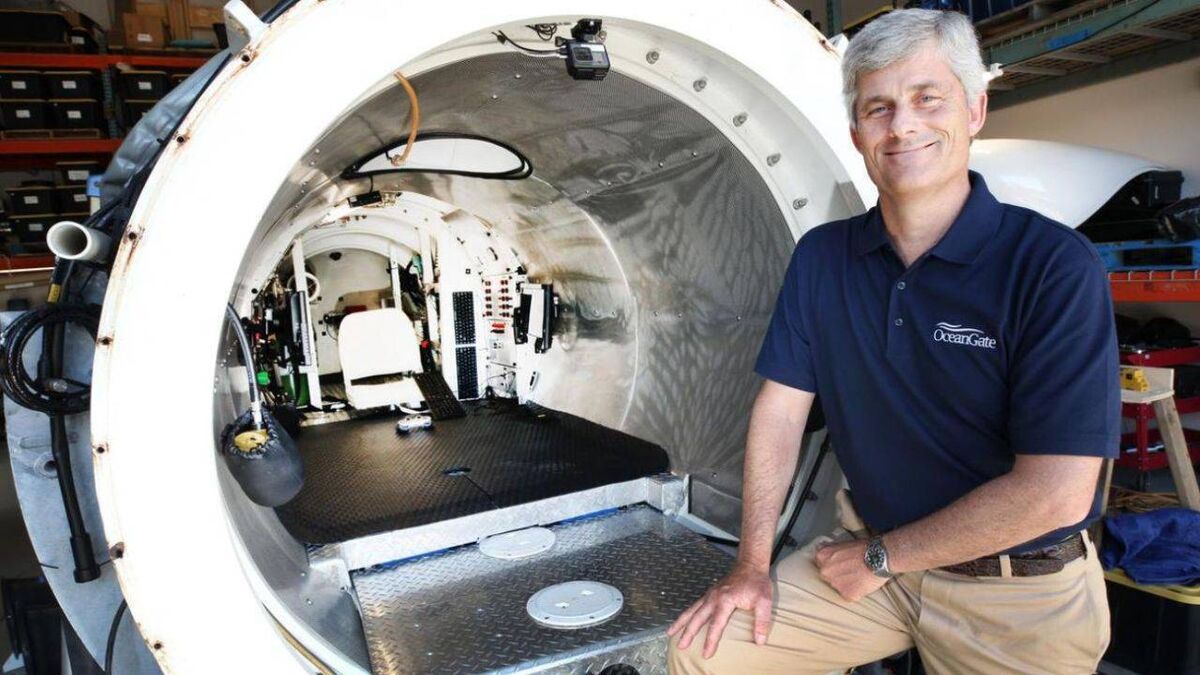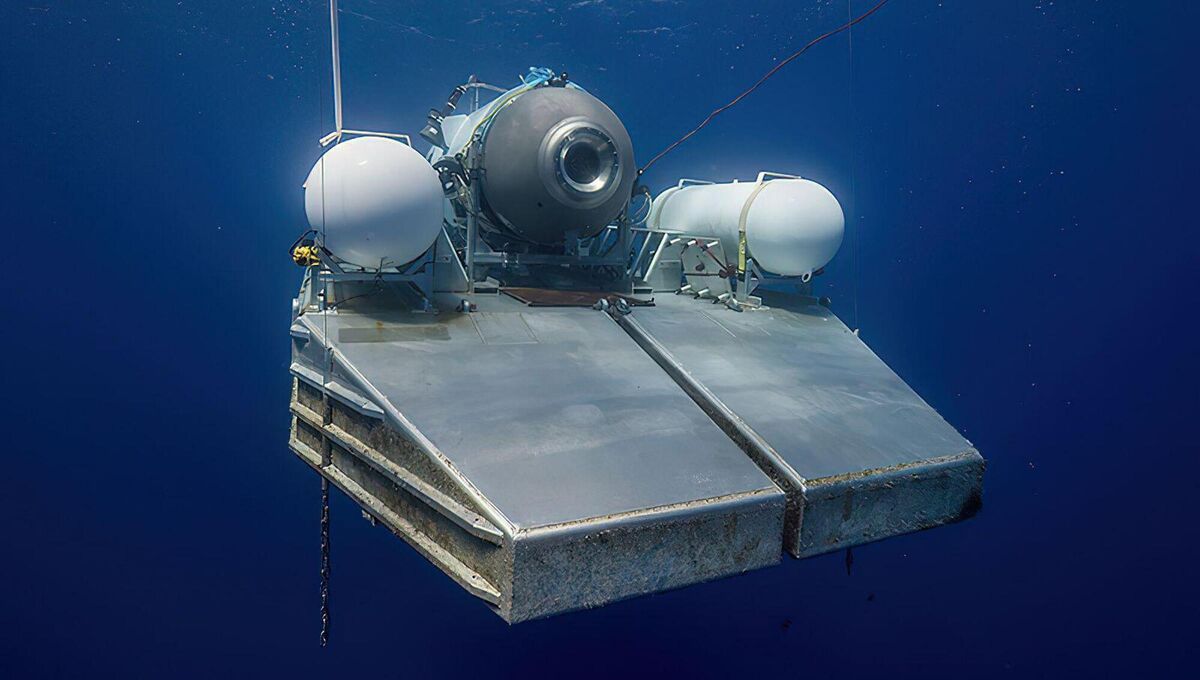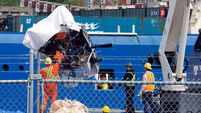US Coast Guard: Crew on missing Titanic sub have just 20 hours of breathable air remaining

The OceanGate Expeditions vessel used to examine the wreckage site of the Titanic. (Action Aviation, PA)
The five-man crew of the submarine which went missing during a voyage to the wreck of the Titanic may have less than 20 hours of breathable air remaining, if they are still alive, a US Coast Guard official has said.
The sub, named Titan, lost communication with tour operators on Sunday while about 435 miles south of St John’s, Newfoundland, during a voyage to the shipwreck off the coast of Canada.
Speaking on this afternoon, Rear Admiral John Mauger said it would be hard to determine exactly how long those inside the submersible night have, due to various factors.
He said that the 20 hour estimate is based on an initial estimate which suggested said the vessel had a 96-hour supply of oxygen.
Earlier, Rear Admiral Mauger told that US Coast Guard said that underwater noises detected in the search area of a missing deep-sea vessel is a “target” and a “focus” for the rescue operation.
“This is an incredibly complex site there, you have to remember that it’s the wreck site of the Titanic, so there is a lot of metal and different objects in the water around the site," he said.
“That’s why it’s so important that we’ve engaged experts from the navy that understand the science behind noise and can classify or give us better information about what the source of that noise may be.
“In the meantime, it’s something, it’s a target, it’s a focus for us to look at.
“We’ve deployed the remote-operated vehicles and the surface vessel, the Canadian Coast Guard surface vessel, that has sonar capability in the vicinity of that to see if we can detect anything in the water in that area.”
The 6.7m long vessel has five people on board.
They are Shahzada Dawood, his son Suleman and OceanGate’s chief executive and founder Stockton Rush, reportedly together with French submersible pilot Paul-Henry Nargeolet and British billionaire Hamish Harding
Noises have been detected from the search area of the missing deep-sea vessel near the wreck site of the Titanic as those on board face a dwindling supply of oxygen.

The US Coast Guard on Wednesday morning said: “Canadian P-3 aircraft detected underwater noises in the search area. As a result, ROV (remote operating vehicles) operations were relocated in an attempt to explore the origin of the noises.
“Those ROV searches have yielded negative results but continue.
“Additionally, the data from the P-3 aircraft has been shared with our U.S. Navy experts for further analysis which will be considered in future search plans.”
The Explorers’ Club, of which Mr Harding is a founding member, shared an upbeat message on Wednesday morning.

President Richard Garriot de Cayeux said in a statement: “There is cause for hope, that based on data from the field, we understand that likely signs of life have been detected at the site.
“They precisely understand the experienced personnel and tech we can help deploy… We believe they are doing everything possible with all the resources they have.”
Mr Garriot de Cayeux said they are ready to provide the UK-based Magellan’s remotely operated vehicle (ROV) that is certified to travel as deep as 6,000 metres.
Meanwhile, US media outlet The Rolling Stone reported an internal US government memo said “banging” was detected by Canadian search aircraft in 30-minute intervals on Wednesday.

It comes as a former employee of OceanGate had raised concerns over “safety and quality control issues regarding the Titan to OceanGate executive management”, according to court filings.
David Lochridge, OceanGate’s former director of marine operations, claimed in the August 2018 court document he was wrongfully fired after flagging worries about the company’s alleged “refusal to conduct critical, non-destructive testing of the experimental design”.
After “issues of quality control” with Titan were raised, the filings say Mr Rush asked Mr Lochridge to conduct a “quality inspection” report on the vessel.
During this process, Lochridge “identified numerous issues that posed serious safety concerns” but he was allegedly “met with hostility and denial of access” to necessary documents before later being fired.
The document claims he became concerned about a “lack of non-destructive testing performed on the hull of the Titan”, and that he “stressed the potential danger to passengers of the Titan as the submersible reached extreme depths”.
In a November 2022 episode of his Unsung Science podcast, CBS journalist David Pogue interviewed Mr Rush ahead of going on a Titan expedition to the wreckage.
In the podcast, Mr Rush told him: “You know, at some point, safety is just pure waste.
“I mean, if you just want to be safe, don’t get out of bed, don’t get in your car, don’t do anything.
“At some point, you’re going to take some risk, and it really is a risk-reward question.
“I think I can do this just as safely by breaking the rules.”

Mr Pogue also said he had signed a waiver before going on the dive which allegedly said: “The experimental submersible vessel has not been approved or certified by any regulatory body” and that the trip could result in death.
OceanGate has been approached for comment.
On Tuesday David Mearns, a deep-sea shipwreck hunter who is friends with Mr Harding and Mr Nargeolet, said he had seen reports of “tapping” being heard in the water, which he said could indicate the passengers are alive.
He told : “There’s some reports that I’ve just read from my own club, which is how I know Hamish, is that somebody today has heard some tapping.
“Now they’ve got sonar buoys out there, there may be some other hydrophones that the mothership the Polar Prince had in the water.
“It’s hard to imagine how they could have heard that but still, they are at least trying to operate or encourage the rescue efforts to continue on and to be redoubled on the fact that they’ve heard something which suggests that the men are alive in the submersible.”
On Tuesday, Captain Jamie Frederick of the US Coast Guard said a “unified command” of multiple agencies was formed on Monday to tackle the “very complex problem” of finding the missing submersible.














